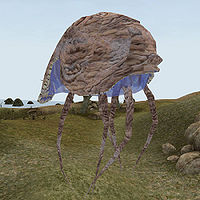The Bestiary of Mundus and Oblivion includes widely varied and often dangerous creatures. Many examples of creatures such as the skittish deer or the clever wolf, beasts such as the dreaded werewolf or the young dragonling, and the damned undead — including the lowly zombie and the powerful lich — are included in this guide; this clearly demonstrates the extent and variety of the creatures that inhabit the universe. This overview serves to describe how animals and monsters affect the world, how the environments they live in have affected them, and their roles in the world in general.

Creatures in General
Creatures serve many uses throughout Mundus and Oblivion. Some serve as beasts of burden for carrying people and cargo, such as the horse or the guar. Others are used for war, such as the clannfear which are often used as summoned creatures to defend mages or as soldiers in Daedric armies. Undead creatures such as the zombie are often used as guards or as experiment subjects by necromancers. It is common for animals and monsters to be hunted as food or for their fur, bones, or alchemical properties. In some cases they are even used as building supplies, most notably in the case of the Redoran city of Ald'ruhn where the Redoran Council maintains a Manor District under the shell of an Emperor crab. Some animals can also serve as pets, an obvious case being the dog. In some cases they are used as a work force; the goblin is often used by the Altmer as a work force, and in some cases certain other creatures such as the ogre are enslaved and made to live a life of forced labor.
A creature may serve one primary purpose, but that does not mean its role is set in stone. Many creatures can serve as food, pets, wildlife, or as mindless monsters to be slain or avoided whenever found.
Creatures can also have unexpected effects on environments. In Vvardenfell the Ghostfence that was intended to stop the spread of the blight was undermined in several ways. One notable way the blight spread out of containment on Red Mountain was the cliff racers living around the mountain; the cliff racer's ability to fly made the Ghostfence an almost laughable measure of containment as they could fly above the gate at will, which helped spread the blight throughout the island. This is not the extent of the cliff racer's effects on Vvardenfell; it was first an invasive species. It migrated into Vvardenfell from parts unknown and attacked and slowly overwhelmed the native dragon population. Eventually the dragons were fully driven out of Vvardenfell and their home there, Red Mountain. The cliff racers remained a dangerous threat to anyone who would travel to the already dangerous mountain until they were rumored to be driven out of Vvardenfell by Saint Jiub.
Though an animal or monster can alter or even damage its environment and ecosystem, its chosen ecosystem is often necessary for its survival. A creature chooses to live where it can survive, which means that its environment must complement their abilities or lifestyles. Skeletons and other undead can often be found in ruins or in necromancer lairs. Slaughterfish and the dreugh can be found underwater.
Many creatures have become domesticated by other races. Farms will often raise creatures and animals such as the sheep and cow which are rarely found outside of domestic environments due to their inability to survive wilderness areas.
Some creatures such as the rat can be found in many different environments. Rats can be found in sewers, ruins, caves, the wilderness, goblin run farms as food, and even in homes as pets! Like the rat some other creatures can be found in a variety of locations serving a variety of roles. Dogs, for example, are kept as a pets but can also be found serving as guards for camps or in some ruins.
See Also
- Game-specific bestiaries: Arena • Daggerfall • Battlespire • Redguard • Morrowind • Tribunal • Bloodmoon • Dawnstar • Shadowkey • Oblivion • Shivering Isles • Skyrim • Dragonborn • Online
